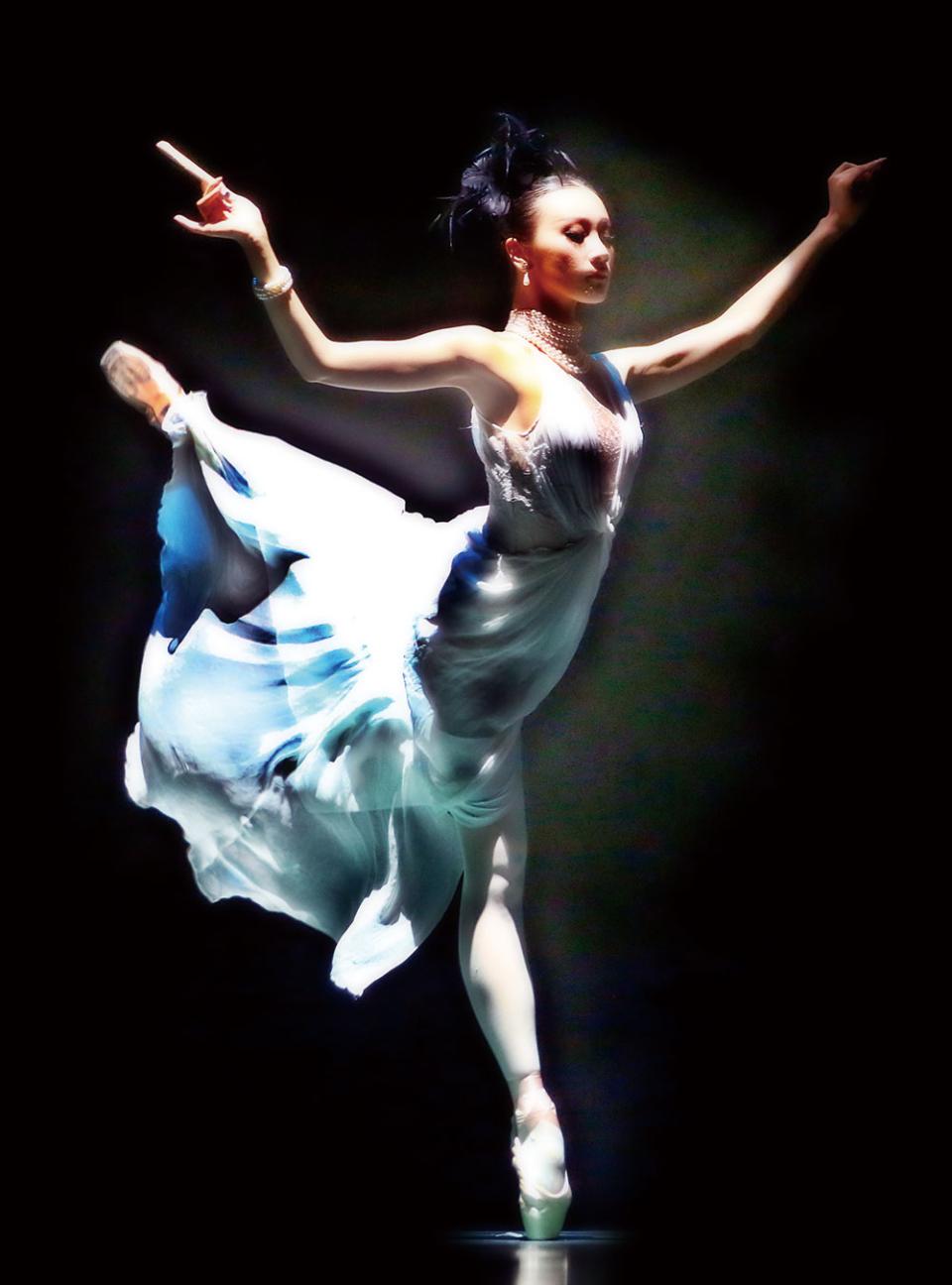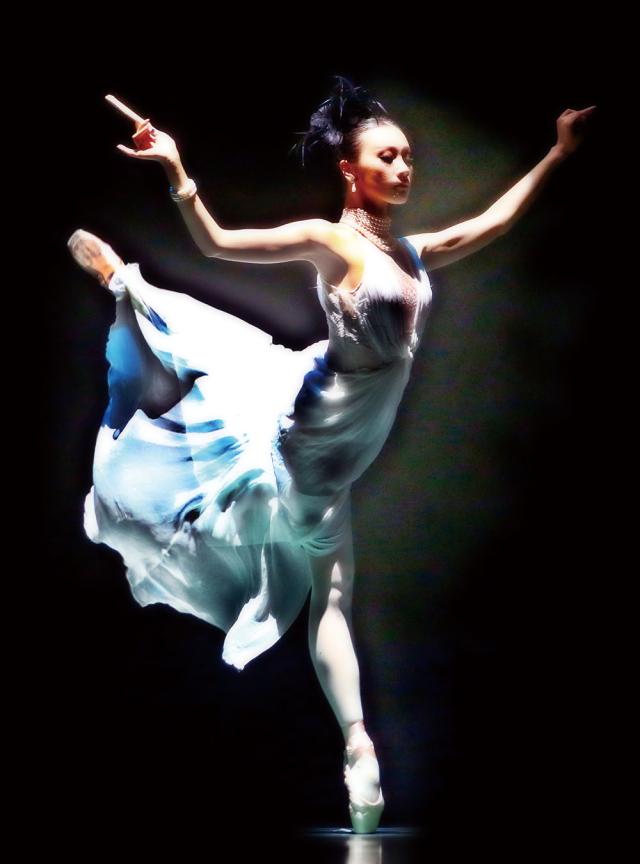With the notes of Chopin’s “Nocturnes” flowing in the dark, an ethereal figure in white, suspended on a hanging thread of silk, danced in the air. Gracefully and slowly, she swung and descended against a beam of icy blue light, like a swan dancing on a cloud.
The unfolding scene was from Dreams in Cloud – Chopin’s Nocturnes, a ballet performed in midair, directed and performed by the noted ballerina, choreographer and producer, Sisi Qiu.
The 29-year-old artist has charmed Western audiences with her flexibility and grace, and was the first Chinese performer in the Bavarian State Ballet, a leading independent ballet company that attracts top talent from around the world.
“I’m pursuing freedom,” Qiu said. The rebellious and innovative “swan” enjoys breaking boundaries and exploring possibilities for herself as well as her work. “A good dance does not need any explanation. It will still touch the audience. There is no need to set limitations on your work,” said Qiu.
Eastern Swan
Qiu’s journey began at age eight, when she trained in the southern Chinese city of Guangzhou under famous ballet educator Peng Wu, who belonged to China’s first generation of modern dancers. Although she was older than her peers, the girl’s attentiveness and perseverance made a deep impression on Peng.
“Even though she was a little girl, her performance of modern ballet was extremely expressive and powerful. She was born for this art,” Peng told NewsChina.
In 1995, Qiu left Guangzhou for the Shanghai Ballet School, and five years later was admitted to the Mannheim University of Music and Performing Arts in Germany on a full scholarship.
Upon graduation in 2003, Qiu auditioned at the Bavarian State Ballet, competing against over 400 rivals from all over the world, many of whom were already professional dancers. Qiu successfully passed the audition and joined the company as its youngest ballerina.
Her five years in the Bavarian State Ballet, from 2003-2007, was one of the most precious experiences in Qiu’s life. Each year, Qiu performed at nearly a hundred shows worldwide and worked with world-class maestros, which greatly deepened her understanding of her art.
In 2007, she moved to Paris to take an MBA course at Mod’Art International. Usually dancers choose to become choreographers after they stop performing on stage. Yet, ambitious as Qiu was, she hoped for more.
“Some senior dancers who were fantastic on the stage are quite unsure about their future when they have to face the end of their stage career. I don’t want to step towards an unclear future in my beloved ballet shoes. I hope I can always dance freely and happily until the last minute of my life,” Qiu told NewsChina.
After getting her MBA degree in luxury and fashion management in 2009, she decided to return to China and established the Wave Art Studio in Beijing.
The year 2010 marked a watershed moment in Qiu’s life as she presented her first production, Chopin en Pointe, to celebrate the 200th anniversary of Chopin’s birth. The show toured Beijing, Shanghai, Guangzhou, Prague and other cities. Qiu was not only the lead dancer but, even more importantly, she was the producer and needed to organize every detail of the whole show. But she was not afraid of navigating this new role. “I like facing challenges that are beyond my ability,” Qiu said.
For Qiu, dancing on stage is like entering another world. Every day Qiu switches roles from dancer to choreographer to producer, and enjoys her daily trips from imagination to reality.
“As a producer I have to deal with many complicated issues. But when I come back to the stage, I can leave all these concerns behind and plunge into the world of ballet. It is unrealistic to live completely in an ideal world, but it is also not enough to live totally in the mundane world.”
“Ballet and I are like a pair of lovers, always at arm’s length from each other. I’ve tried many different things in these years, like designing jewelry, hosting art exhibitions and cooperating with fashion brands, but that does not mean that I am turning away from ballet. Instead, I’ve blended ballet into every moment of my life,” said Qiu.
The Soul of Dance
Qiu sees ballet as an art of extreme pain and pleasure. While talking to our reporter, she pointed at a pair of exquisite ballet shoes behind her, and said, “You have to experience a lot of difficulties and pains to grow into a professional ballerina. People can see you swiftly dancing as a shining, gorgeous princess on stage, but they can’t see how much effort you’ve made behind the stage, your clothes soaked with sweat, with pair after pair of worn-out shoes thrown away.”
Since a very young age, Qiu has spent a great deal of her time in front of the exercise room mirror measuring each movement and step, striving for perfection. For Qiu, endowing each dance with its own spirit, instead of performing mechanically, requires a long process of exploration.
Qiu recalled one unforgettable experience she had during her studies in Germany when she prepared the classic solo “The Dying Swan.” The piece requires a deep understanding of art, music and life from performers to reach perfection.
In the very beginning, Qiu was frustrated as she found it very difficult to perform well. But she was surprised when Brigitte Keil, the principal of the Mannheim University of Music and Performing Arts, gave Qiu two days off and suggested she spend two days among forests and lakes.
“I thought it was quite strange at first. I couldn’t understand why I was given two days off when my performance was so unsatisfactory. But later it proved that the unexpected experience taught me how to find the real spirit of the piece,” said Qiu.
That weekend beside the lake in Munich is deeply etched in Qiu’s memory. “I observed how swans swam on the lake, how they communicated with each other, what they were like when alone, and then I suddenly realized that in the past, when I practiced ‘The Dying Swan,’ I was merely copying other dancers’ performances. My previous understanding of this solo was just in my head. But when I immersed myself in nature, I gradually found the key to the performance. Sometimes dancers should take off their ballet shoes, leave the exercise room and set out on a journey to explore the soul of dance.”
Boundless
As a creator, Qiu enjoys breaking the boundaries of ballet and finding new ways to express this classic art, such as introducing pop music, combining art with fashion, or drawing inspiration from Asian music and dance.
Qiu’s first experience of creation dates back to her days in the Bavarian State Ballet when she attempted to choreograph a pas de deux, CAFÉ 1930, by combining Astor Piazzolla’s tango with ballet, a piece which made a highly acclaimed debut in Munich. The successful creation stimulated her and since then she has been exploring more possibilities in ballet.
In early 2011, after reading the love poems of the sixth Dalai Lama, Tsang Yang Gyatso (1683-1706), the artist decided to combine ballet with local traditions to create a dance about Tibet. She went to Tibet several times over the next two years to learn more about Tibetan music and dance, and to experience the plateau herself. Clad in a long, red dress, Qiu danced swiftly besides the bank of Lake Nam as well as at the foot of the Potala Palace. Qiu said she felt that her body and spirit had completely blended with ballet, and that she had become one with heaven and earth.
Last year, Qiu collaborated with her former teacher Peng Wu to create Ballet of the Tea, a dance that combines classic ballet with the indigenous dance of Guizhou Province. The story tells the romance between a British tea merchant and a tea spirit. Qiu tried to use the language of ballet to express the essence of traditional Chinese tea culture.
Qiu was inspired by the collision of ballet and indigenous dance when she and Peng collected local songs and dances in Guizhou Province. Unlike the delicate, refined form of ballet, Guizhou’s indigenous dance is far more intense, forceful and emotionally expressive. Qiu was deeply impressed by how passionate the local dancers were while performing, and how freely and straightforwardly they expressed their emotions through their art.
“The beauty of art is that it never sets a clear boundary or fixed answers for creators. There are a hundred Hamlets in a hundred readers’ minds. Similarly, a hundred viewers may have a hundred different interpretations of the same ballet. But the pleasure that the appreciation brings is common to everyone,” said Qiu. “I want to create a thousand different effects in a thousand different performances.”

 Old Version
Old Version
